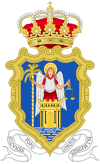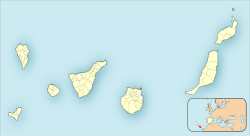Santa Cruz de La Palma
| Santa Cruz de la Palma | |||
|---|---|---|---|
| Municipality | |||

Santa Cruz de La Palma
|
|||
|
|||
 |
|||
| Location in the Canary Islands | |||
| Coordinates: 28°41′N 17°46′W / 28.683°N 17.767°WCoordinates: 28°41′N 17°46′W / 28.683°N 17.767°W | |||
| Country |
|
||
| Autonomous community |
|
||
| Province | Santa Cruz de Tenerife | ||
| Island | La Palma | ||
| Founded | 3 May 1493 | ||
| Government | |||
| • Alcalde | Sergio Carlos Matos Castro (Partido Socialista Obrero Español (PSOE)) | ||
| Area | |||
| • Total | 43.38 km2 (16.75 sq mi) | ||
| Elevation | 4 m (13 ft) | ||
| Population (2013) | |||
| • Total | 16,330 | ||
| • Density | 380/km2 (970/sq mi) | ||
| Demonym(s) | Santacrucero,ra | ||
| Time zone | WET | ||
| • Summer (DST) | WEST (UTC) | ||
| Postal code | 38700 | ||
| Official language(s) | Spanish | ||
| Website | Official website | ||
Santa Cruz de la Palma (Spanish for Holy Cross of La Palma) is a city and a municipality in the eastern part of the island of La Palma in the province of Santa Cruz de Tenerife of the Canary Islands. It is situated on the east coast. Santa Cruz de la Palma is the second largest city (after Los Llanos de Aridane) and is the capital of the island. It is located along an old lava flow coming out from the Caldereta (small caldera), a volcano located just south of the city.
The population of the municipality is 16,330 (2013), its area is 43.38 km². Around 13,000 people live within the city limits, with the remaining population residing in other settlements.
The city was founded by Alonso Fernández de Lugo on May 3, 1493. It was located between a river which is situated by a cave named Tedote (now Cueva de Carías, located north of the city). The city, originally called Villa del Apurón, served as a port that connected routes to the Americas, exporting goods from the island such as sugarcane. The city was sacked by pirates and was later reconstructed and fortified against future pirate attacks. Famous fortifications include the Castillo de Santa Catalina and Castillo de la Virgen. The economic crisis that affected the agriculture sector brought the greatest loss of population in the city's history, which limited its expansion and caused the population to stabilize and drop to 11,000. The population did not approach its original 18,000 again for the next hundred years.
Santa Cruz de la Palma has a hot semi-arid climate (Köppen BSh) featuring very warm, almost rainless summers from April to September, and warm, rainier winters from October to March.
Santa Cruz de la Palma has the only major port in the island, serving ferry routes to Cádiz in Spain, as well as to Tenerife, Gran Canaria and Lanzarote. The main ferry operators in the port are Naviera Armas, Fred. Olsen Express, and Trasmediterránea. Many cruise line firms visit the port.
...
Wikipedia



